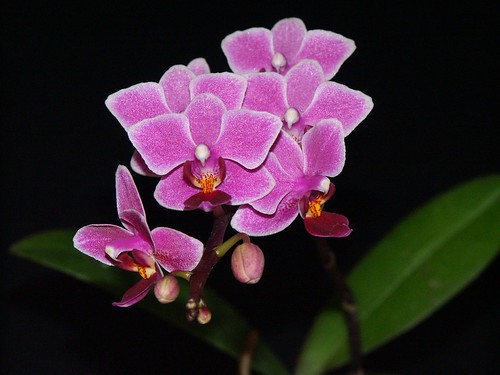Growing orchids indoors is not complicated. They can be easily incorporated into your indoor garden. Probably the simplest way to approach indoor orchid growing is to find orchid plants that suit your existing environments. Windowsills, sun rooms, under skylights and windowsill greenhouses are perfect places for growing Phalaenopsis,Cattleya, Dendrobium, Cymbidium and many more types of orchids.
When deciding on an place for growing orchids indoors, watch for these things:
- What is the maximum and minimum temperatures there? Is it too cold in the winter or too hot in the summer? Don’t assume that it is room temperature just because it is indoors. When the leaves of an orchid touch the window glass heated by the blazing hot sun, it can still get burned. Likewise, the leaves can freeze if they touch the window in the winter. Use a min/max thermometer and you can see the minimum and maximum temperature at that spot throughout the day. Also make sure that the night temperature is at least 10°F to 15°F (5°C to 8°C) cooler than the daytime temperature.
- How much light does it provide? This is likely different throughout the year. Choose the types of orchids that suit the light intensity. If your light is too intense, you can drape a piece of chiffon between the orchid and the light source to reduce the intensity.
- What is the humidity there? Again, humidity various throughout the day and throughout the year, and even throughout the home. To keep an orchid happy, humidity needs to be at least 40% at any time.
- Is there sufficient air movement at that spot? Bacteria and fungus will invade your orchids if there isn’t enough air circulation.
Because micro-climates exist in any spot, placing your plant several inches away can give you dramatic different results. For example, five inches from the window might be too little light, but if you move it three inches closer to the window, your Phalaenopsis might receive enough light. A spot next to the heater might be quite a lot warmer than one several feet away, but it may be a lot dryer as well. Experiment and test many spots to find your perfect indoor garden.
All hopes are not lost if your indoor environment doesn’t fit the requirements. Technology makes everything possible. You can transform your dungeon-like basement into the wildest indoor garden your heart desires. Artificial lights, humidifiers, fans, heaters and coolers can be used to supplement your natural environment or can be used to create a growing area from an enclosed room. You can even buy ready-made orchidariums or Wardian cases that have all this equipment installed. Alternatively, you can build a terrarium with minimal cost. Your setup can be as elaborated or as humble as your budget allows.
Some growers believe that if you are growing orchids indoors, moving them outdoor in the summer will benefit their health. Check out the benefits and disadvantages before you decide whether you should allow your orchids to have a summer vacation outdoors.
If you grow your orchids outdoors, on your balcony or patio, you can still bring them indoors to enjoy their blooms. Many orchid flowers actually last longer if you keep them out of bright lights. Some of them will twist their spikes to face the light if the light source direction is changed.
Watering is a little tricky when you grow your orchids indoors. Check out some tips I have to water more efficiently.
Happy growing!

